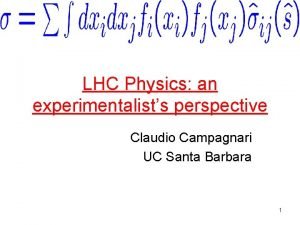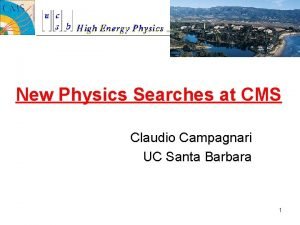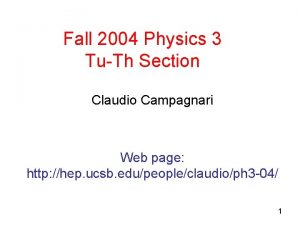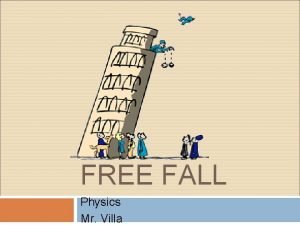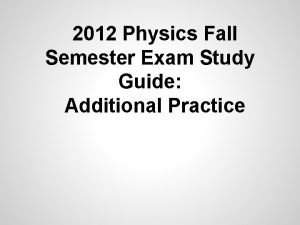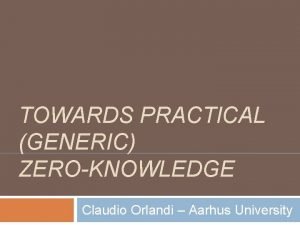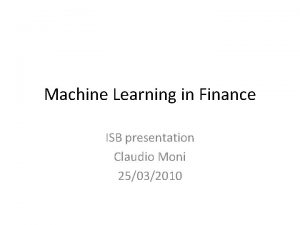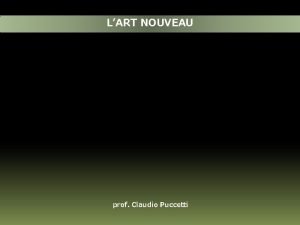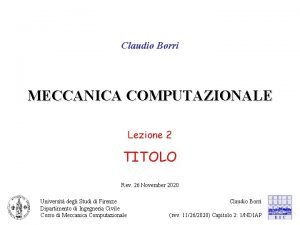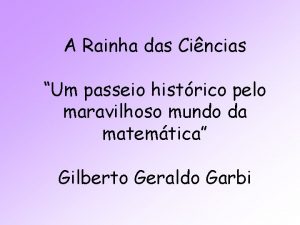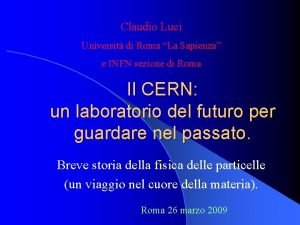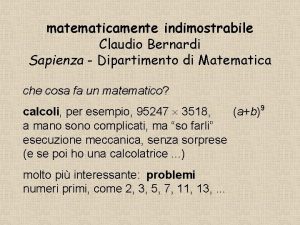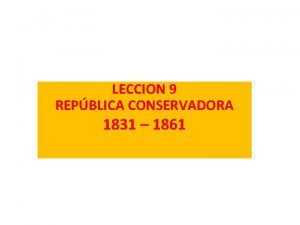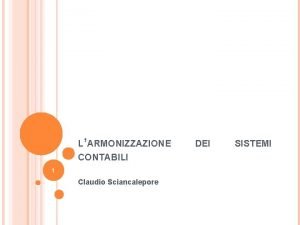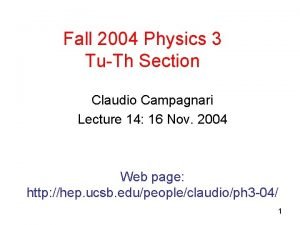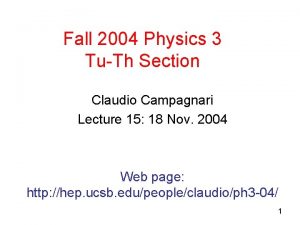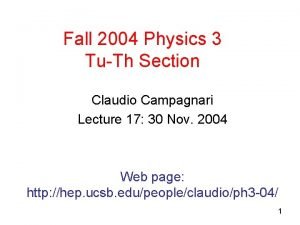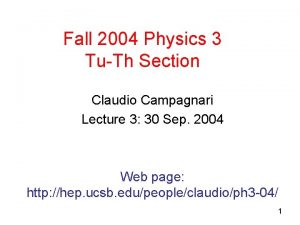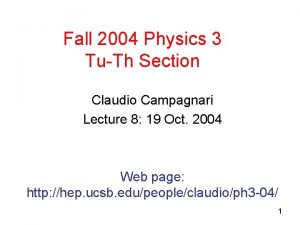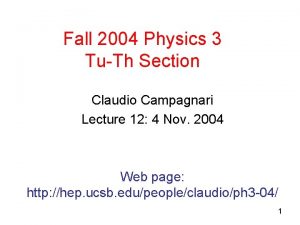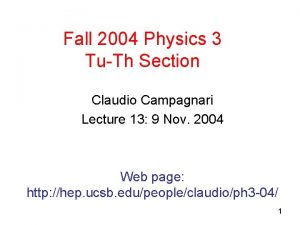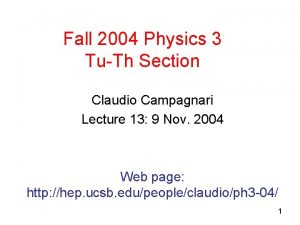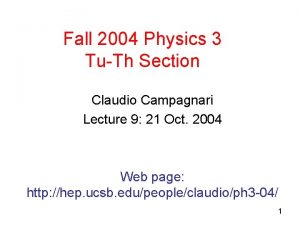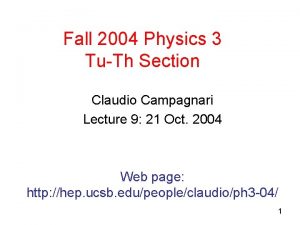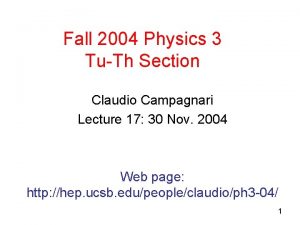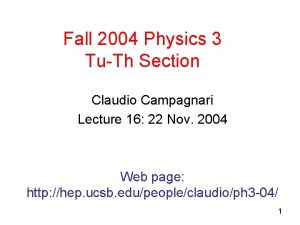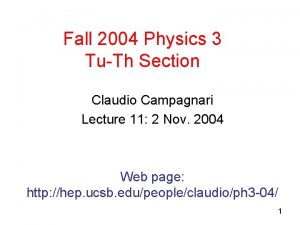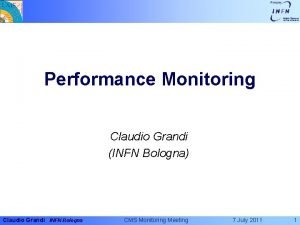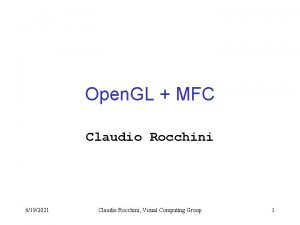Fall 2004 Physics 3 TuTh Section Claudio Campagnari































- Slides: 31

Fall 2004 Physics 3 Tu-Th Section Claudio Campagnari Lecture 6: 12 Oct. 2004 Web page: http: //hep. ucsb. edu/people/claudio/ph 3 -04/ 1

Electric Field Coulomb force between two charges: Q A different picture: Ø consider the charge Q all by itself: Q If I place a charge q 0 at the point P, this charge will feel a force due to Q 2

Electric field (cont. ) Q • One way to think about it is this: The charge Q somehow modifies the properties of the space around it in such a way that another charge placed near it will feel a force. • We say that Q generates an "electric field" • Then a test charge q 0 placed in the electric field will feel a force Electric field (vector!) Q Test charge at P 3

Electric Field Definition • If a test charge q 0 placed at some point P feels an electric force F 0, then we say that there is an electric field at that point such that: • This is a vector equation, both force and electric fields are vectors (have a magnitude and a direction) q 0>0 q 0<0 • Electric field felt by some charge is created by all other charges. • Units: Force in N, Charge in C Electric Field in N/C 4

Gravitational Field • The concept of "field" should not be new to you • Mass m near the surface of the earth, then downward force F=mg on the mass • Think of it as where is a gravitational field vector • Constant in magnitude and direction (downwards) • Correspondence Electric Field Gravitational Field Eletric charge Mass 5

A detail • Imagine that have some arrangement of charges that creates an electric field • Now you bring a "test charge" q 0 in • q 0 will "disturb" the original charges Ø push them away, or pull them in • Then the force on q 0 will depend on how much the initial charge distribution is disturbed Ø which in turn depends on how big q 0 is • This will not do for a definition of E E is defined for an infinitesimally small test 6 charge (limit as q 0 0)

Electric Field from a single charge Q r Definition of electric field due to charge Q at the point where charge q 0 is placed. Magnitude of electric field due to Q at a distance r from Q. 7

Electric Field from a single charge (cont. ) Q r • Direction of the electric field at point P? • Points along the line joining Q with P. Ø If Q>0, points away from Q Ø If Q<0, points towards Q Q>0 q 0>0 Q>0 q 0<0 Q<0 q 0>0 Q<0 q 0<0 8

Example 1 (electric field of a dipole) Dipole: a collection of two charges q 1=-q 2 P b Q d c q 1>0 a R q 2=-q 1 Find the electric field, magnitude and direction at 1. Point P 2. Point Q 3. Point R 9

Start with point P P y b W q 1>0 a x V q 2=-q 1 U VECTOR SUM! Problem setup: 1. Complete labels • Label point U, V, W • Angle 2. Choose axes 3. Work out some geometrical relations • UW=UV= ½ a • UP=UW tan b = ½ a tan • UP=WP sin b = WP sin • UW=WP cos ½ a = WP cos Key concept: Total electric field is the sum of field due to q 1 and field due to q 2 Electric field due to q 1: points away from q 1 because q 1 > 0. Call it E 1 Then: In components: E 1 x = E 1 cos and E 1 y = E 1 sin 10

y P x E 1 x = E 1 cos and E 1 y = E 1 sin b W q 1>0 a V q 2=-q 1 U Now need E 2 = electric field due to q 2 Points towards q 2 (because q 2 < 0) Symmetry: • |q 1| = |q 2| and identical triangles PUW and PUV E 2 x = E 1 x and E 2 y = - E 1 y Ey = 0 and Ex = 2 E 1 cos 11

P b q 1>0 a q 2=-q 1 Now need to express sin 2 and cos in terms of stuff that we know, i. e. , a and b. Note that I do everything with symbols!! We had Also, trig identity: 12

13

y Q c a q 1>0 q 2=-q 1 2. Now want electric field at point Q x E 1 due to charge q 1 points away from q 1 (q 1>0) E 2 due to charge q 2 points towards q 2 (q 2<0) Q c q 1>0 a q 2=-q 1 There are no y-components. Ex = E 1 x + E 2 x 14

y d q 1>0 a R q 2=-q 1 3. Now want electric field at point R x E 1 due to charge q 1 points away from q 1 (q 1>0) E 2 due to charge q 2 points towards q 2 (q 2<0) q 1>0 a d q 2=-q 1 There are no y-components. Ex = E 1 x + E 2 x 15

Example 2 (field of a ring of charge) x P • Uniformly charged ring, total charge Q, radius a • What is the electic field at a point P, a distance x, on the axis of the ring. • How to solve Ø Consider one little piece of the ring Ø Find the electric field due to this piece Ø Sum over all the pieces of the ring (VECTOR SUM!!) 16

d. E = electric field due to a small piece of the ring of length ds d. Q = charge of the small piece of the ring Since the circumference is 2 a, and the total charge is Q: d. Q = Q (ds/2 a) 17

z • The next step is to look at the components • Before we do that, let’s think! Ø We are on the axis of the ring Ø There cannot be any net y or z components • A net y or z component would break the azimuthal symmetry of the problem Let’s just add up the x-components and forget about the rest! 18

What is going on with the y and z components? z d. Q d. S’ The y (or z) component of the electric field caused by the element ds is always exactly cancelled by the electric field caused by the element ds' on the other side of the ring 19

Now we sum over the whole ring, i. e. we take the integral: 20

Time to think about the integral now. The integration is "over the ring" • k is a constant of nature • a is the ring-radius, a constant for a given ring • x is the distance from the center of the ring of the point at which we want the E-field, x is also a constant =Q 21

Sanity check: do limiting cases make sense? What do we expect for x=0 and x ? • At x=0 expect E=0 Ø Again, because of symmetry Ø Our formula gives E=0 for x=0 • As x , ring should look like a point. Ø Then, should get E k. Q/x 2 Ø As x , (x 2+a 2) x 2 ØThen E kx. Q/x 3 = k. Q/x 2 22

Example 3 (field of a line of charge) 2 a x P • Line, length 2 a, uniformly charged, total charge Q • Find the electric field at a point P, a distance x, on axis 23

As in the case of the ring, consider field due to small piece (length dy) of the line. Charge d. Q = Q dy/(2 a) As in the case of the ring, no net y-component Ø Because of cancellation from pieces at opposite ends Let’s just add up the x-components 24

d. Q = Q (dy/2 a) d. Ex = d. E cos y = r sin x = r cos r 2 = x 2 + y 2 25

Look up this integral in a table of integrals 26

Sanity check: do limiting cases make sense? What do we expect for x 0 and x ? • As x 0 expect E= Ø Because at x=0 right "on top" of a charge Ø Our equation works • As x line should look like a point ØThen, should get E k. Q/x 2 Ø As x , (x 2+a 2) x 2 ØThen E k. Q/(xx) = k. Q/x 2 27

Another limiting case • Suppose line is infinitely long (a ) • Define linear charge density =Q/2 a Ø Charge-per-unit-length • If a , but x stays finite: x 2 + a 2 • Then, denominator xa 28

Jargon and common symbols • If you have charge on a line (e. g. wire) ØLinear charge density ( =Q/L) = charge-per-unit-length • If you have charge on some surface Ø Surface charge density ( =Q/A) = charge-per-unit-area • If you have charge distributed in a volume ØVolume charge density ( =Q/V) = charge-per-unit-volume 29

Electric Field Lines • A useful way to visualize the electric field • Imaginary lines that are always drawn parallel to the direction of the electric field • With arrows pointing in the direction of the field 30

Some properties: Ø Lines always start on +ve charges, end on –ve charges Ø Density of lines higher where the field is stronger Ø Lines never cross • Because at each point the field direction is unique 31
 Claudio campagnari
Claudio campagnari Claudio campagnari ucsb
Claudio campagnari ucsb Claudio campagnari ucsb
Claudio campagnari ucsb Free fall
Free fall Physics fall final exam review
Physics fall final exam review Physics fall semester exam review
Physics fall semester exam review Claudio duran
Claudio duran Claudio orlandi
Claudio orlandi Bishop claudio gatti
Bishop claudio gatti Claudio porzio
Claudio porzio Colegio claudio matte temuco
Colegio claudio matte temuco Claudio traini
Claudio traini Isb machine learning
Isb machine learning Claudio puccetti
Claudio puccetti Claudio nicolini
Claudio nicolini Enegrama 3
Enegrama 3 Claudio borri
Claudio borri Claudio storelli
Claudio storelli Pepe el ciego
Pepe el ciego Claudio possani livros
Claudio possani livros Dott. claudio nappo
Dott. claudio nappo Claudio bortolin
Claudio bortolin Claudio traini
Claudio traini Claudio orlandi
Claudio orlandi Spadon claudio
Spadon claudio Claudio maffeis
Claudio maffeis Cláudio murillo cavalcanti
Cláudio murillo cavalcanti Claudio luci sapienza
Claudio luci sapienza Claudio boisier troncoso
Claudio boisier troncoso Claudio bernardi matematica
Claudio bernardi matematica Fotos de chile leccion 9
Fotos de chile leccion 9 Claudio sciancalepore
Claudio sciancalepore
